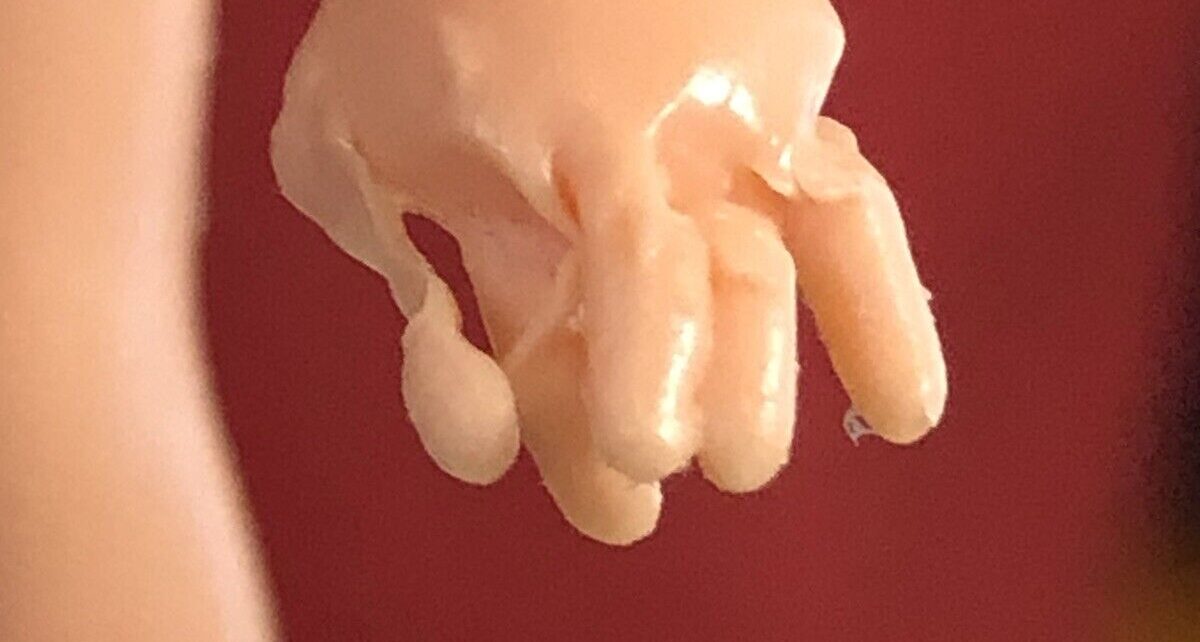
My childhood Barbies were always in trouble. I was constantly giving them diagnoses of rare diseases, performing risky surgeries to cure them, or else kidnapping them—jamming them into the deepest reaches of my closet, without plastic food or plastic water, so they could be saved again, returned to their plastic doll-cakes and their slightly-too-small wooden home. (My mother had drawn her lines in the sand; we had no Dreamhouse.) My abusive behavior was nothing special. Most girls I know liked to mess their Barbies up; and when it comes to child’s play, crisis is hardly unusual. It’s a way to make sense of the thrills and terrors of autonomy, the problem of other people’s desires, the brute force of parental disapproval. But there was something about Barbie that especially demanded crisis: her perfection. That’s why Barbie needed to have a special kind of surgery; why she was dying; why she was in danger. She was too flawless, something had to be wrong. I treated Barbie the way a mother with Munchausen syndrome by proxy might treat her child: I wanted to heal her, but I also needed her sick. I wanted to become Barbie, and I wanted to destroy her. I wanted her perfection, but I also wanted to punish her for being more perfect than I’d ever be.
It’s not that I literally wanted to become her, of course—to wake up with a pair of hard plastic tits, coarse blond hair, waxy holes in my feet betraying the robotic fingerprint of my factory birthplace—but some part of me was already chasing the false gods she spoke for: beauty as a kind of spiritual guarantor, writing blank checks for my destiny; the self-effacing ease afforded by wealth and whiteness; selfhood as triumphant brand consistency, the erasure of opacity and self-destructive tendency. I craved all of these—still do, sometimes—even as my own awareness of their impossibility makes me want to destroy their false prophet: Barbie as snake-oil saleswoman hawking the existential and plasticine wares of her impossible femininity, one Pepto-Bismol-pink pet shop at a time.
Even after I grew out of playing with Barbies, I found a surrogate to embody the same fraught double helix of adoration and resentment: the popular girl. As a figure, the popular girl was at once supernatural—larger than life—and many-headed all around me. At my prep school in Los Angeles, popular girls were everywhere, spritzing themselves with the Gap perfume called Heaven and presumably all gathering at the same Beverly Hills mansion to snort coke, get waxed, and act aloof around the same boys who only ever spoke to me if they were asking to borrow my TI-82 graphing calculator. It only got worse when I became friendly with two of these popular girls—we ran cross-country together—and found them wickedly funny, and (worse) genuinely nice. It all seemed like a cosmic clerical error, a lopsided allocation of assets. The story that was helping me survive my own adolescence—that the popular girls were hopelessly vapid and morally bankrupt—had collapsed; now I had a more robust vision of their superiority, validated and verified, to wear like a hair shirt. Turns out that Barbie was just the first name I gave to the lifelong project of punishing myself with the imagined perfection of others.
If Barbie embodied something that always felt beyond my reach, then playing with Barbie—subjecting her to an array of trials and tribulations—was less about becoming her than it was about exerting some sort of power over the archetypes that tyrannized me. I didn’t have to become her; I could be her god—a loving god, or a vengeful one. Walter Benjamin once observed that “ownership is the most intimate relationship that one can have to objects,” but—as everyone knows—intimacy is never a pure feeling. It’s never as simple as unmitigated affection or adoration; it’s always striated with resistance and resentment. Perhaps this is what Barbie offers, the chance to feel both things at once: wanting something and wanting to destroy it. Wanting to become something and hating yourself for wanting to become it.
Greta Gerwig’s summer blockbuster, “Barbie”—fuelled by a marketing campaign so large you can practically see it from outer space—knows that much of Barbie’s appeal stems from the fact that people love to hate her. The film’s slogan promises “If you love Barbie, this film is for you; If you hate Barbie, this film is for you,” a pledge that seems to knowingly get it while actually missing the point entirely. It frames love and hate as mutually exclusive states, when Barbie’s power rises from her ability to make you love her and hate her at once.
In the early stages of developing Barbie, in the late nineteen-fifties, Mattel commissioned a report from a marketing expert named Ernest Dichter, who recommended leaning into rather than away from Barbie’s potential as an antagonist: perhaps instead of “a nice kid, friendly and loved by everyone,” she could be “vain and selfish, maybe even cheap?” Dichter’s report understood that hating Barbie is not so much an act of rebellion as it is part of the plan.
Gerwig’s “Barbie” certainly knows that little girls—or, at least, a certain kind of little girl—likes to ruin her Barbies: deface them, torture them, dismember them. One of the film’s pivotal characters is Weird Barbie, played by Kate McKinnon, a Barbieland misfit who has turned strange because “someone played with her too hard in the real world.” We see a flashback montage of the cruel experiments that have left her with clownish makeup, streaked and singed hair, and legs stuck in “permanent splits.”
But Weird Barbie, like the Weird Sisters in “Macbeth,” becomes a kind of dark guide, serving up unwanted truths. She helps the film’s heroine—Margot Robbie’s Stereotypical Barbie—make sense of what is happening to her, as her “perfect” life and “perfect” body succumb to a series of glitches: her morning waffle is burnt. Her milk has curdled. Her plastic feet—permanently molded to high heels, even when she isn’t wearing them—have flattened, so that her heels (to her horror) now touch the ground. As in Chantal Akerman’s classic film “Jeanne Dielman, 23 quai du Commerce, 1080 Bruxelles,” trouble first shows up as a series of minor domestic disruptions. (In Akerman’s film, a pot of overcooked potatoes is the first sign that something is afoot.) In a female life circumscribed by domesticity or fantasy, these banal disruptions are the seismograph upon which deeper tremors first make themselves felt.
For Barbie, these tremors eventually force her to reckon with the claustrophobic chokehold of her own seamless existence. Her body begins to age, her thighs rippling with cellulite, and she finds herself ambushed by anxieties about her own mortality. In the middle of her own disco party, Barbie asks her gold-lamé-clad friends, “Do you guys ever think about dying?” and the music suddenly stops. No one responds. Barbie corrects herself, “I mean, I’m just dying to dance,” and the music kicks up again.
When Barbie seeks counsel from Weird Barbie, she is told that she will have to cross from Barbieland to the real world to seek out the little girl playing with her. (“You are becoming inextricably intertwined,” Weird Barbie says. As Benjamin could have told her, they always were.) The film’s promotional materials describe the quest that ensues—Barbie rides her neon Rollerblades right into the real world, where she immediately gets catcalled by a cluster of construction workers—as a “full-on existential crisis.” But, at the end of the day, it’s a Mattel-authorized crisis. Does it ultimately disrupt Barbie’s brand or simply consolidate it? (As Slavoj Žižek argues, fair-trade coffee is also a clever bit of inoculation designed to make us feel better about capitalism.)
Indeed, it turns out that even Barbie’s existential crisis is—quite literally—a call coming from inside the corporate house; specifically, from a high-level executive assistant named Gloria (America Ferrera) who works on the top floor of the Mattel headquarters. Gloria is a lifelong Barbie devotee, but mother to a teen, Sasha (Ariana Greenblatt), who has emphatically outgrown hers. Gloria has been secretly drawing rogue Barbie models at her desk: Crippling Shame Barbie, Cellulite Barbie, and Irrepressible Thoughts of Death Barbie.
These rebel designs are part of a “dark Barbie” lineage: In “Barbie’s Real Life,” a series of photographs from the eighties, Susan Evans Grove gives us Office Politics Barbie, standing by a desk full of papers, getting groped from behind; Battered Barbie, her under eye smeared with black makeup; and Go Ask Barbie, who leans over a toilet bowl of floating pills. In Todd Haynes’s cult classic “Superstar,” his 1987 bio-pic about the life and death of the singer Karen Carpenter, a Barbie plays the film’s titular anorexic. Part of the irony of casting Barbie as Karen is that Barbie-Karen already has a body whose proportions would require illness to sustain. In 1994, a group of Finnish researchers infamously published a study arguing that a real-life woman with Barbie’s proportions would not menstruate.
But under Haynes’s direction, Barbie gets even thinner: to dramatize Carpenter’s illness, Haynes physically chipped away at his doll to make her appear more emaciated, until she is all sharply angled plastic cheeks and skeletal arms. We see a closeup of her doll eyes, blackly terrified at the prospect of a large restaurant meal. We see closeups of her Ex-Lax boxes, her tiny salads, the miniature bottles of ipecac syrup that eventually damage the muscles of her heart beyond repair. The recurring shots of her bathroom scale echo Slumber Party Barbie (1965), who came with a scale permanently set at a hundred and ten.
At one point, we watch Karen’s brother Richard berating her with his scolding concern: “All you ever eat is salad and iced tea!” His worries are less altruistic than instrumental: “Your fans are worried. I can hear them gasping when we walk onstage!” When Richard finds Karen passed out at her dressing-room table, next to an empty box of Ex-Lax, he rages: “What did you do to your makeup? You’re a mess!” The one thing Barbie is never allowed to be: a mess. Which is precisely why we always want to mess her up.
The first time my daughter asked for a Barbie, soon after her fifth birthday, I felt the sense of dread that comes from watching the protagonist of a horror film jimmy open a locked door at the end of a dark hallway. Don’t go in there! Among other things, I worried that her desire for a Barbie would signal the end of an era: her two-year fascination with the goddesses of Greek mythology. My pride in her love for these myths was aspirational, no doubt insufferable. I loved her savvy questions: “Why is Zeus everyone’s daddy?” “Was Medusa a regular woman before she was a monster?” I loved the ways these myths helped her metabolize the inevitable cruelties and betrayals of the world; the ways they helped her reckon with her own contradictory desires for dependence and distance; and, perhaps most of all, the ways they gave her so many fierce and complicated female figures to arrange her mind around. Wise and ferocious Athena with her owl and her unnerving, bad-ass birth, straight from the forehead of Everyone’s Daddy! Or operatic Demeter, plunging the whole world into winter with her sorrow. Or even Persephone, who wanted to rejoin her mother while also carving out a separate identity as queen of the dead. I loved that these goddesses all had their own flaws and self-thwarting desires: Athena and her pride; Hera and her jealousy; Aphrodite and her vanity. These goddesses were psychic chiaroscuros: powerful and wounded, their blood running hot with ambition, animated by dark attachments and shameless hungers.
The first time my daughter asked for a Barbie—to be precise, a Butterfly Princess Barbie—it was hard to imagine this princess, frothy with butterfly-studded pink tulle, bursting out of her father’s skull or putting snakes into an infant’s crib (as Hera had done to baby Hercules, one of her husband’s many children by other women). It was as if, from the glorious ranks of the Greek goddesses, with their superhuman flaws and flashing eyes, only one had survived: Aphrodite. As if her beautiful form had endured as the only possible template for what a woman might fantasize about becoming. (Mattel in fact released a trio of Goddess Barbies in the late aughts: Medusa, Athena, and Aphrodite, framed against a pastel seashell. But the dolls were designed for collecting, not play, and they barely move; Aphrodite’s limbs are capable of almost no articulation at all.)
Hearing my daughter first say the word “Barbie” felt like a foreshadowing of all those tyrannical tenets of feminine existence I wanted to shield her from: punishing ideals of beauty, whiteness and its fantasies of innocence. What I fear about my daughter’s attachment to her Barbies is something I fear in myself: that I serve the wrong gods, false ones. But we can’t simply reject our false gods. We must figure out what they’ve done for us. As a wise shrink once told me, “You’ll never get over your anorexia until you figure out what it does for you.”
My own mother, I know, went through her own version of this Barbie grief—when I requested my own Barbie, for the first time, thirty-five years ago. For more than sixty years, in fact, daughters have wanted Barbies that their mothers did not want them to have. This, too, was part of Mattel’s vision for the doll, and part of the reason it was the first toy company to market directly to children, via television, rather than parents. There’s nothing a girl wants more, perhaps, than a toy it seems like her mother does not want her to have.
The story of Barbie has always been a story about mothers and daughters. The very first Barbie—created by a businesswoman named Ruth Handler, the first president of Mattel—was named after her own daughter, Barbara. She first came into the world on March 9, 1959, wearing a black-and-white-striped bathing suit, with red lips and a high blond ponytail. Handler liked to tell the story of Barbie’s origins as a polished autobiographical anecdote: that she had seen her own daughter playing with adult paper dolls and was inspired to create a doll that was not a baby; that would allow little girls to imagine their own futures. Over the years, it would become clear that Handler had specific ideas about what these futures might look like. Barbie has had more than two hundred careers—from McDonald’s employee to paleontologist, Marine Corps sergeant to ballerina—but she has never become a mother. Handler herself once said in an interview, “If I had to stay at home I would be the most dreadful, mixed-up, unhappy woman in the world.”
When Mattel was pressured into making Barbie a mother, the closest it came was introducing Barbie Baby-Sits, in 1963, a set including an infant doll, a list of phone numbers to call, and a pocket watch—reminding us that soon this sitter would be off the clock. The set also came with miniature books: “How to Travel” (a reminder that this sitter was still a free agent, rather than a “dreadful, mixed-up” homebound mother), “How to Lose Weight”—its pages featuring just two words of text, “Don’t Eat”—and “How to Get a Raise,” a reminder that this Barbie was not a mother but, rather, a merchant of her own time, a woman getting compensated for her labor.
Although Handler narrated Barbie’s origins in personal terms, her true birth story was a bit more complicated: Barbie owed much of her design to a German fashion doll called Bild Lilli, a risqué gag gift launched in Germany in 1955, based on a comic-strip character who first appeared sitting down with a fortune-teller, asking, “Can’t you give me the name and address of this tall, handsome, rich man?” The writer M. G. Lord, in her book “Forever Barbie: The Unauthorized Biography of a Real Doll,” offers a shrewd read of Lilli in the context of postwar Germany as a “vanquished Aryan, gold digging her way back to prosperity.”
The Handlers did not just have a daughter named Barbie, they also had a son named—yes—Ken, who never wanted to buy Barbies for his own daughters and has long been troubled by his parents’ cultural legacy: “I felt a lot of indignation about the effect the dolls had on impressionable children.” Lord describes Ken as a long-haired and shaggy-bearded man who looks nothing like his doll doppelgänger. He laments Barbie’s impossible body (“a figure no young lady could ever achieve without a severe anorexic leaning”) and lets himself imagine an elaborate alternative version of the doll, more committed to global injustice: “If they were to suddenly come to life . . . I would like to take Barbie and Ken and train them as ethnobotanists . . . take their blond selves . . . and tan themselves in the sweat of the equatorial-jungle sun and give themselves to people that desperately need to learn from them.” Though Ken’s fantasy carries its own bizarre texture—a pre-ayahuasca fetishizing of the jungle meets a modern-day “White Man’s Burden”—it’s also a daydream that falls neatly in line with two long-standing Barbie traditions: not only imagining elaborate ways to make Barbie feel uncomfortable but also using her to act out a minor rebellion against one’s parents.
The psychologist D. W. Winnicott made famous the concept of the “transitional object” as a beloved childhood possession, often a Teddy bear or security blanket, that becomes a kind of surrogate mother, allowing the child to separate, and I wonder if for many girls Barbie functions as a kind of post-transitional object: not a surrogate mother so much as an anti-mother; a version of the self that does not need to mother or be mothered; a proto-teen-age self that can push the mother away more forcibly. Barbie is not a doll for snuggling. She is made of hard plastic—meant for manipulation and mischief more than comfort. Many nights I help my daughter navigate a similar drama of bedtime ambivalence: she wants one of her Barbies to sleep with her, but—because the doll is so unyielding—she does not want to lie too close to it.
When my daughter plays with her Barbies, she can undermine their composure in any way she chooses: the Barbie who is sad because she wasn’t allowed to go to the birthday party; the Barbie who needed sidekick medicine from the weedy reaches of our back yard, because otherwise her sickness would be a forever sickness till the end of time. Barbie’s tribulations are endless. Among other things, she is always losing her shoes. (I think often of the sadist who made her high heels removable—good to grant Barbie that mercy, I suppose, but for the rest of us it’s endless, the hunt for her tiny plastic shoes.) My daughter’s imagination reckons with Barbie’s pristine existence, rather than swallowing it whole, and her play is not exclusively about identification but, rather, many vectors of engagement: punishing, wrestling, saving. She wants to do all kinds of things with her dolls besides just be them. I’m pleased to see this, even as I also understand that part of what she needs is the opportunity to do things I am not pleased to see.
It felt like a stroke of cosmic irony that I ended up seeing “Barbie” in Greece, the birthplace of the goddesses that Barbie has recently displaced. This was opening weekend, on the island of Crete, and, on the way to the theatre, I’d passed a storefront full of lacy thongs and satin bras called “Barbie lingerie,” and, a few stores down, a toy shop full of endless Barbie boxes, while a little girl beside me tugged on her mother’s hand, speaking rapidly in Greek, her fluted voice striking those universal notes of longing: “Ah . . . Barbie . . .”
Gerwig’s film wrestles with maternity from the get-go. Its opening shots of little girls playing with baby dolls in the desert is not only an homage to Stanley Kubrick’s “2001: A Space Odyssey,” its protohumans discovering tools, but also an opportunity to highlight Barbie’s anti-maternal impulses: “At first, girls could only play at being mothers,” Helen Mirren’s voice-over laments. “How much fun is that? Why don’t you ask your mother?” But once Barbie arrives—the original doll from 1959, looming like a giant in her zebra swimsuit—the girls start smashing their baby dolls against the rocks. They’ve been given permission to rage against the straitjacket of motherhood. But what will give them permission to rage against the straitjacket that has arrived, gigantic and blonde, to take its place
The film proceeds to offer its own riff on the fall from innocence: humanity’s expulsion from the Garden of Eden. (In Barbieland, Barbie doesn’t have a vagina, but once she chooses to become “fully human,” she appears to get one—and the film closes with her triumphant visit to the gynecologist: fig leaf finally removed.) If it’s Eve who first succumbs to temptation in the Bible, then it’s Ken who eats the apple here: after accompanying Barbie to the “real world,” he finds himself falling in love with the patriarchy—which he understands, charmingly, as a society in which “men and horses have all the power”—and ends up bringing toxic masculinity back to Barbieland, like an invasive species. (As if Barbieland does not already have this version of masculinity as part of its foundation—would Barbie ever have existed without masculinity?)
The cure for this outbreak? Gloria ends up snapping all the Barbies out of their collective brainwashing by offering an incisive catalogue of all the paradoxical gender scripts they now have to navigate: “You have to say you want to be healthy, but you also have to be thin. . . . You’re supposed to love being a mother, but don’t talk about your kids all the damn time.” And it works. Barbie cries out triumphantly, “By giving voice to the cognitive dissonance required to live under the patriarchy, you’ve robbed it of its power!” (The word “patriarchy” must appear in the film at least forty times.) This is the fantasy of an artist or an analyst—this faith that giving voice to something will rob it of its power—and it gestures implicitly toward the larger aspirations of the film itself: that a corporate-sponsored film about Barbie could repair the damage she’s done by describing it, the brand equivalent of a carbon-neutral flight.
Don’t get me wrong: “Barbie” is brilliantly imagined, and endlessly delightful, but its social critiques are neither original nor disruptive. They ratify articles of shared liberal understanding so that the film can get on with the business of redeeming its heroine—giving us a Barbie we can stand behind. The film’s monologues about the patriarchy are simultaneously incisive and incessant—their sheer abundance, one imagines, meant as an assertion of directorial autonomy. Its commentary is strongest in its narrative absurdities (a thousand Kens eager to “explain ‘The Godfather’ ” to a rapt female audience) and tongue-in-cheek asides, the tonal equivalent of the teen-age girl who appears fleetingly at the end of the film, winking at us as she puts on her makeup. Gerwig might be winking, but she is still putting on her makeup.
The part of “Barbie” that I ultimately found most compelling was its reckoning with various forms of motherhood—not so much its actual mother and daughter, Gloria and Sasha, but its evocation of subtler maternal bonds: the relationships between Barbie and her creator, and between the artist and capitalism. Barbie quite literally meets her maker on the seventeenth floor of Mattel’s headquarters, in a secret room that looks like a mid-century American kitchen. Handler (played by Rhea Perlman) introduces herself as “Ruth” and offers herself as a refuge from the men in suits who are chasing Barbie through the building, trying to force her (literally) back into her box. Eventually, Ruth accepts Barbie’s desire for full humanity, and, in this way, the film offers a version of the Fall that also serves up a fantasy of reunion: Barbie gets to eat from the Tree of Knowledge, and she gets to reconcile with her god. She does not have to choose.
If Barbie ends up falling into humanity with her corporate mother’s blessing, choosing to accept suffering and mortality in exchange for full humanity (and a vagina?), it’s also true that her humanity is more about fragility than culpability. Much is made of Barbie’s tears throughout the film, their glittering novelty—and her newly acquired humanity involves foregrounding her vulnerability rather than facing the harm she’s caused. The film’s most explicit critiques of Barbie come from the thirteen-year-old Sasha, who is at once a Barbie critic and an updated Barbie model: Progressive Politics Popular Girl. Sure, she’s wearing her Gen-Z armor—stringy hair, ripped jeans, fierce indignation. (She accuses Barbie of embodying “sexualized capitalism” and sends her away in tears.) But, even as Sasha seems to push back against Barbie, she still embodies what Barbie has always represented: the terrifying power of the popular girl, consolidating her own power by making someone else feel terrible.
Gerwig’s film does something similar: ostensibly interrogating the icon whose reach it was designed to expand. In its opening weekend, the film grossed nearly four hundred million dollars worldwide; and one can only guess how many Barbies Mattel has sold in the past month. Ultimately, we can see the film’s genesis as another iteration of the fraught parent-child dynamic that Barbie has always catalyzed: Gerwig as a headstrong daughter pushing back against her benefactor, an auteur both resisting and milking the dark mother of capitalism, a child casting off the parent-brand whose resources have made her work possible. This is not to say that Gerwig’s art is hypocritical, only that it’s emblematic: the artist interrogating the same compromised structures that underwrite her ventures in the first place. 







